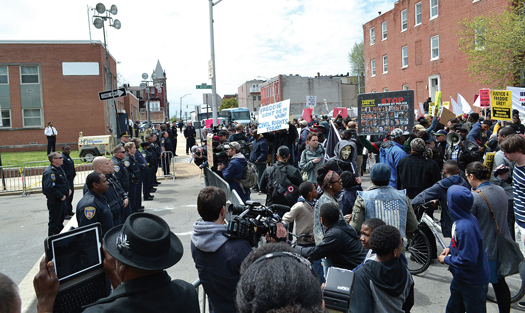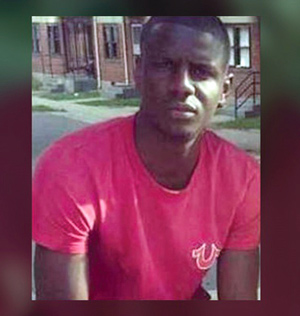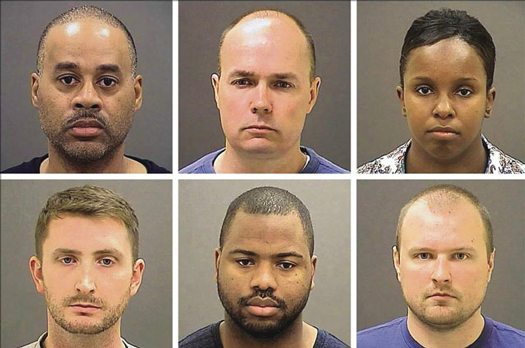Justice remains elusive in Freddie Gray Case
By Barrington M. Salmon -Contributing Writer- | Last updated: Jun 28, 2016 - 8:44:22 PMWhat's your opinion on this article?

Protest at the Baltimore Police Department Western District building at N. Mount St. and Riggs Ave. near the site of Gray’s arrest on April 25, 2015.
|
BALTIMORE—Every time one of the police officers implicated in the death of Freddie Gray is found not guilty, it is yet another slap in the face of Baltimore residents seeking justice for Gray.
This scenario played out again when Circuit Court Judge Barry Williams acquitted Baltimore Police Officer Caesar Goodson of all seven charges against him. Off. Goodson faced charges including manslaughter, second-degree depraved-heart murder and reckless endangerment. Judge Williams—who has skewered the prosecution—said as he read his opinion and verdict in the bench trial that the prosecution offered theories that were not backed by evidence—adding “the court cannot simply let things speak for themselves.”

Freddie Carlos Gray, Jr. was killed while in police custody, April 19, 2015.
|
Judge Williams was also skeptical of the prosecution’s contention that Off. Goodson’s failure to secure Mr. Gray’s seat belt or provide him medical treatment led to his death. Three of the six officers charged have had trials. The trial of Off. William G. Porter ended in a mistrial and Off. Edward Nero was acquitted by Judge Williams in May.
The resulting riot and civil unrest in West Baltimore in 2015 tore the scab off a complex tangle of racial, social and economic issues that have battered Baltimore’s Black residents for more than 40 years.
Last May, Mr. Gray—who had committed no crime is said to have eyeballed some cops and ran. It’s not clear when exactly Mr. Gray sustained his injuries but cellphone videos of his arrest show an obviously injured Mr. Gray being dragged between two bicycle cops to a paddy wagon. He suffered fatal spinal injuries from an almost severed neck.
Residents’ emotions run the gamut from anger to frustration and resignation. There is concern that no one will ultimately be held responsible for Mr. Gray’s death. In fact, a Baltimore criminal lawyer echoed the sentiment in a recent interview on National Public Radio that while Mr. Gray’s death is tragic, it doesn’t necessarily mean that anyone is responsible.
Charm City resident Kevin Ben shook his head when asked if the verdict surprised him or if he expected a guilty verdict.
“Nope,” said Mr. Ben, a 23-year-old musician and graphic design artist. “His parents took the money too quickly. You can word it any way you want, it was a payoff. It takes years to get help for education but they found $6.4 million to pay the family. Even if they find someone guilty, it won’t be like murder or anything. (State Attorney) Marilyn Mosby may have been over her head. You always feel for your hometown. That may be what drove her. She wanted to get to the bottom of what happened, do the right thing.”
“Our people just want answers, justice. They just want closure. There’s no reason why anyone is being beaten and killed with no accountability.”
Lenworth Jackson, a Sandtown-Winchester resident, put much of the blame on States Attorney Mosby.
“I really do think the prosecutors messed up the whole case by mishandling it,” he said as he sat on a stoop in West Baltimore contemplating the questions. “Instead of being thorough, she rushed her investigation. I think she could have done it in three-to-six months. I don’t know how she did it but it’s a waste of time to continue. She needs to let it go.”
States Attorney Mosby has come under increasing criticism by those in the legal community, the Fraternal Order of Police and a rising chorus of residents who say she overreached. Critics question the haste with which she completed her investigation, others abhor her public pronouncements on the steps of the Baltimore War Memorial to secure justice for Mr. Gray as parts of the city smoldered from riots and arson. A conviction in the Goodson case would have bolstered the prosecution but in the aftermath of Off. Goodson’s acquittal, the likelihood of the other officers being found guilty is in jeopardy.

Baltimore police officers charged in the death of Freddie Gray. Top row left to right: Caesar R. Goodson Jr., Garrett E. Miller and Edward M. Nero. Bottom row left to right: William G. Porter, Brian W. Rice and Alicia D. White. Officers Nero and Goodson were acquitted and Officer Porter received a mistrial. Photos: en.wikipedia.org
|
A city dogged by segregation, color and class
Baltimore, residents and experts say, it’s a city with a decades-long foundation and legacy of racism and segregation which continues to bedevil present-day residents. Baltimore is two distinct cities—separate and deeply unequal. There is one world inhabited by the wealthy or affluent, replete with manicured lawns, country clubs, six- and seven-figure jobs and a cushion of wealth, entitlement and privilege that protects these people from the vagaries of life; another is the middle class where some are comfortable while others push and struggle to hold onto the American Dream. This segment has been hollowed out by economic stagnation, unemployment, jobs shipped overseas and a precipitous and constantly changing job landscape. And then there are the poor and dispossessed.
The vast majority of the dispossessed are Black residents who are part of a group that have been denied the access, skills and education that would likely lift them out of their tough circumstances. They have been victimized by deep-rooted structural inequities, a substandard educational system; the closure of Bethlehem Steel, one of the city’s largest employers and other companies like it; policy choices that have devastated inner-city communities; and a police department that has served more often as an occupying force than one that protects and serves.
Sandtown is a 72-square-block area in West Baltimore, home to almost 9,000 residents of whom 98 percent are Black. The community got its name from the trails of sand that spilled from wagons leaving town after filling up at the local sand and gravel quarry in the era of horse-drawn wagons. Sandtown was once a bustling middle-class community where Cab Calloway, Billie Holliday and Supreme Court Justice Thurgood Marshall resided, but during the late 20th century, crime, an economic depression, race riots and residents fleeing the community devastated Sandtown. Currently, half of the children live in poverty, a third of the houses are abandoned, more than 30 percent of the residents are unemployed, three percent of the residents are behind bars and the homicide rate is more than double the citywide average.
According to the Baltimore Sun, despite an injection of $130 million of public and private money into the housing between 1989-1999, Sandtown-Winchester has not been transformed in the manner planners, politicians and community leaders had anticipated. The reasons vary but they include a lack of further investment, no real accounting of where the money went and how it was spent. There have been notable improvements over the past 20 years with more residents earning high school and college degrees, fewer living in poverty and an increase in homeownership.
Yet, these gains have not been enough to permanently flip Sandtown-Winchester.
Doni Glover, who was born and grew up in East Baltimore but who now lives in West Baltimore, said sometimes looks are deceptive.
“In order to gauge what’s changed in a year and a month, it’s almost impossible to look at the Freddie Gray scenario without understanding that we’re in an election year,” said Mr. Glover, a newspaper publisher and author. “No matter what you see, everything being done is related to the election.”
“With regards to Mayor Stephanie Rawlings-Blake, the machine that chose her picked a new candidate. The establishment is still intact. (Former Gov.) Martin O’Malley helped her get into office. Her father, Howard ‘Pete’ Rawlings, was a former delegate who ran the money. He was chairman of the Appropriations Committee, the Big Willy. Part of his wish was for his daughter to become mayor, it was said.”
Mr. Glover, a radio show host and publisher of the BMORENEWS.com, said elder Rawlings “gave O’Malley a pat on the back to become mayor in 1999 and that was the beginning of the end for Black people because the White element was introduced into the political dynamic.”
Gov. O’Malley, Mr. Glover noted, inflicted what he called “O’Malley’s Reign of Terror” on Black people. As mayor and governor, Mr. O’Malley instituted aggressive public safety measures which led to one of every six Baltimore City residents becoming entangled in the criminal justice system. That translated in 100,000 people or 17 percent of the populace being locked up.
“I hated him as a mayor and governor and I hated his policies,” said Mr. Glover with disgust during an earlier interview.
Mr. Glover also chastised Black Democratic politicians, who he described derisively as “selfish and entitled.”
“Democrats have run Baltimore City for 50 years. It’s not about White people. The real enemy is us,” he said. “Since Kurt Schmoke was mayor, we have one or two generations of residents who’ve never seen politics dominated by strong, Black people. We’re used to running things. We were lenders not borrowers. Now we have Black Democratic elitism and a form of classism in places like D.C., Baltimore and Chicago where Negroes with money don’t mess with Negroes without money. Now Black leaders are ashamed and afraid. Love got us through slavery, love is how we were able to survive this long, baby. But these people don’t know what love is.”
What needs to happen, Mr. Glover said, is a total and thorough shake up of the political establishment.
“Democratic establishment Negroes are still in power. It’s time to vote for some different people,” he said. “We’ve gotten great mileage by voting for a Republican governor.”
Police and residents: An uneasy peace
Black Baltimore residents have complained steadily for decades about their treatment by the police officers patrolling their neighborhoods. They spoke and continue to speak with loathing and resentment of the brutality, disrespect and disdain officers have exhibited. Community leaders chronicle the names and stories of Black men killed by the police, including Anthony Anderson, Dale Graham and Tyrone West.
The riots following Mr. Gray’s death crystallized the divide between both sides. About six blocks from where residents Jackson and Glover live, up the road on Pennsylvania Avenue, looters burned stores and businesses, torched vehicles and shattered glass. Some were venting their anger, others used the opportunity to steal and pillage.
A Baltimore police officer who walks the beat in areas including Sandtown-Winchester said the shooting death of Trayvon Martin in Sanford, Florida in 2012 by wanna-be cop George Zimmerman has tempered the way some of his colleagues deal with the public.
“Policing has changed since Trayvon Martin. Certain officers are afraid for their jobs because they think the department won’t back them,” said the officer who has been in the department for more than a decade and who requested anonymity to speak freely. “People have every right to be outside, I used to be outside. And I got hassled by the police too. Pushed against the wall, put on the ground.”
The officer, who calls himself “homegrown” said he remains disheartened by residents’ unwillingness to assume personal responsibility for their behavior.
“There’s a lack of pride and learned behavior. It disappoints me because I see it every day,” he said. “People need to pull in, cut the bullshit … I encourage people to leave the (drug) environment. I try to be positive but I’m tired of people making excuses, always complaining. People have to pull together as a community but they often pull together to do stupid things, like supporting those young cats on dirt bikes.”
“Police can make a difference in a community especially if you patrol the streets the old-school way. It’s all in what you do. You have to let them see that you have a good heart and people will learn to trust you.”
INSIDE STORIES AND REVIEWS
-
-
About Harriett ... and the Negro Hollywood Road Show
By Rabiah Muhammad, Guest Columnist » Full Story -
Skepticism greets Jay-Z, NFL talk of inspiring change
By Bryan 18X Crawford and Richard B. Muhammad The Final Call Newspaper @TheFinalCall » Full Story -
The painful problem of Black girls and suicide
By Charlene Muhammad -National Correspondent- » Full Story -
Exploitation of Innocence - Report: Perceptions, policies hurting Black girls
By Charlene Muhammad -National Correspondent- » Full Story -
Big Ballin: Big ideas fuel a father’s Big Baller Brand and brash business sense
By Bryan Crawford -Contributing Writer- » Full Story






 Click Here Stay Connected!
Click Here Stay Connected!








